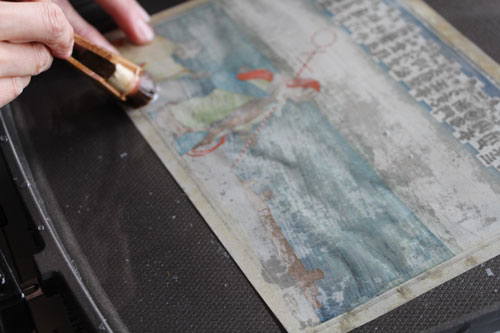Quick! Call an Ambulance!
Did you manage to postpone your 'anticipation' for learning what was in the boxes I mentioned last week? Or did you 'eat the marshmallow', and peek at one of my blogs where I talked about the contents? Relax, I won't ask you to tell me which one it was!
Now because I have written about the contents quite extensively in those other places, I won't recap it all here, but I would like to tell you about how something we found among the contents required us to set up an emergency clinic here in the workshop.
The person who put these goods up for auction was not particularly careful with the description of the contents, and it turned out that there were quite a few surprises in the two boxes. And in fact, I had the first such surprise at the initial moment of looking inside, because instead of the carved woodblocks that I had expected to find in the first box, I came across a stack of hundreds of woodblock prints instead. And what beautiful prints they were! The goods in this auction all seemed to have come from an old printer's workshop, and it seems they specialized in producing the type of prints known as senshafuda. These had originally been nothing more than simple name labels a long time ago, but by the early 20th century had evolved into a genre of colourful and decorative 'collectable' prints. These were produced in sets, commissioned by enthusiasts both for their own pleasure, and for exchange with other groups.
But because they were collectable, it is inevitable that when one today finds a batch of senshafuda like this, they are pasted down into albums. And so it was this time; each and every one of them was glued down onto a horrible backing sheet - an acidic type of paper that over time is corrosive to the beautiful washi. And even worse, the adhesive used was itself strongly acidic, and was causing everything it touched to turn brown.
As soon as I saw the condition of these prints, I knew that we had to get them off those backing sheets, and the sooner the better. So I roped in one of our printer trainees, gave her a quick course in woodblock print restoration, and set her to work.
The procedure for removing prints from backing is simple, but depends on a few important factors: the pigments must be of a type that do not run when the print is moistened, the glue must be soluble (or at least softenable), and the person doing the work must have a very sensitive touch, in order to know how much pressure to apply to the paper so as not to tear the print.
We prepared a stack of well-moistened newsprint, and then dampened each print with pretty much the same methods we use when preparing paper for printing. This stage can be awkward, because if the print and the backing paper expand under the moisture at different rates, the prints can quickly become creased. After the glue had softened sufficiently, we gently teased the prints away from the backing, and then slid them into a bath in a shallow tray of water.

This is the stage of the process that surprises people when they first see it done. It seems incredible that a delicate sheet of (old!) paper - one printed with water-soluble pigments - can actually be safely bathed in this fashion, but they can indeed. We used a fairly stiff brush to clean off the remaining glue, then lifted the sheets out of the water, drained them, and began the careful process of drying them to a perfectly crease-free flat state.
It took us a few days to get through the entire batch, adjusting our process here and there to account for prints that we came across that needed special treatment (those with metallic pigments, special embossings, etc.), but we eventually got them all done, and now have the prints all safely stored in files, where they will be free from further deterioration.
I'm thinking that even though the surgery might have been somewhat scary for them, they are now pretty happy to be here in their new home!
Story #380, April 7, 2013
Comments on this story ...



Posted by: Dave
Hah! I'm already getting emails about this one, not more than a few minutes after it went on-line ...
It seems people want me to include a disclaimer of the 'Don't try this at home!' type. Well, I kind of thought that went without saying, given that I also included phrases such as 'a type that do not run when the print is moistened', or 'must have a very sensitive touch', etc. etc.
But there it is. So yes, if you don't have experience in this sort of thing, then please don't muck about with your prints, especially if they are considered valuable or rare. It is indeed possible to mess them up pretty badly during 'surgery' of this type. We came out of this one with a 99.x% success rate (one small label disintegrated in the bath - we suspect it was actually torn long ago, and pasted down in two pieces), but such results are not likely for people with no experience.